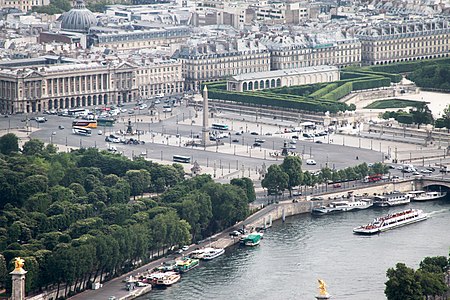Place de la Concorde
Buildings and structures in the 8th arrondissement of ParisExecution sitesNational squaresOlympic basketball venuesOlympic cycling venues ... and 5 more
Olympic skateboarding venuesSquares in ParisTourist attractions in ParisVenues of the 2024 Summer OlympicsWorld Heritage Sites in France

The Place de la Concorde (French: [plas də la kɔ̃kɔʁd]) is one of the major public squares in Paris, France. Measuring 7.6 ha (19 acres) in area, it is the largest square in the French capital. It is located in the city's eighth arrondissement, at the eastern end of the Champs-Élysées. It was the site of many notable public executions, including the executions of King Louis XVI, Marie Antoinette and Maximilien Robespierre in the course of the French Revolution, during which the square was temporarily renamed Place de la Révolution.
Excerpt from the Wikipedia article Place de la Concorde (License: CC BY-SA 3.0, Authors, Images).Place de la Concorde
Avenue des Champs-Élysées, Paris 8th Arrondissement of Paris (Paris)
Geographical coordinates (GPS) Address External links Nearby Places Show on map
Geographical coordinates (GPS)
| Latitude | Longitude |
|---|---|
| N 48.865555555556 ° | E 2.3211111111111 ° |
Address
Place de la Concorde
Avenue des Champs-Élysées
75008 Paris, 8th Arrondissement of Paris (Paris)
Ile-de-France, France
Open on Google Maps









